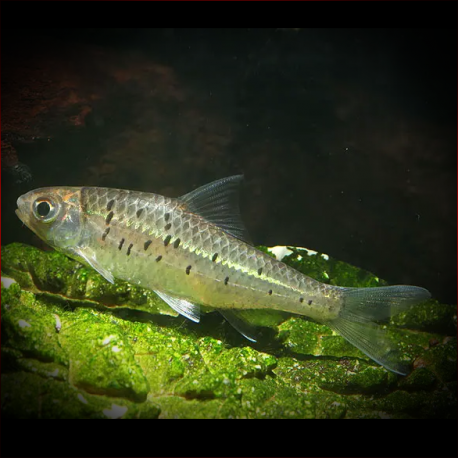More info
Datasheet
| Minimum Tank Size | 240 litres / 63.40 US gallons |
| Maximum Size | 10.0cm / 3.94inches |
| Temperature | 20°C / 68.00°F - 27°C / 80.60°F |
| Hardness | 2.02dgH / 36ppm - 15.02dgH / 268ppm |
| pH | 6.0-7.5 |
General Description
Mystacoleucus greenwayi, commonly known as Greenway's Mystacoleucus, is a slender-bodied fish with a distinctive black margin on its dorsal fin and dark, crescent-shaped markings on its body. This species possesses a unique predorsal spine that can become entangled in aquarium nets, requiring careful handling.
Aquarium Setup
The ideal tank setup for M. greenwayi should mimic a flowing stream or river environment, featuring a substrate of rocks, sand, and fine gravel. Decorate the tank with driftwood, roots, branches, and attached aquatic plants such as Microsorum and Anubias spp. This species requires pristine water conditions with high oxygen levels and moderate water movement. Regular water changes of 30-50% of the tank volume are essential for their well-being (see table for water conditions).
Behaviour
Greenway's Mystacoleucus is not aggressive but can disturb slower or timid tankmates, particularly during feeding. It is recommended to house them with robust, similarly-sized fish species like cyprinids and loaches. In the wild, M. greenwayi forms schools, so maintaining a group of six or more individuals is optimal.
Feeding and Diet
In their natural habitat, M. greenwayi is likely a generalist omnivore, feeding on insects, crustaceans, worms, algae, and aquatic plants. In captivity, ensure a balanced diet by offering live and frozen foods such as bloodworms, Daphnia, Artemia, along with quality dried flakes and granules containing plant materials like Spirulina.
Reproduction & Dimorphism
Reproduction of M. greenwayi has not been documented in aquarium settings. In the wild, spawning occurs during the wet season, typically from April to September. Sexually mature females may exhibit a deeper body compared to males.
Habitat and Distribution
This species is predominantly found in the middle Mekong River basin in Thailand and Laos, as well as the Chao Phraya watershed in central Thailand, specifically in the Ping, Yom, and Nan tributary systems. M. greenwayi thrives in clear, well-oxygenated, running waters with substrates of sand, gravel, rocks, and boulders. In its natural habitat, it coexists with various species including Hampala dispar, Devario laoensis, and Barbodes semifasciolatus.

